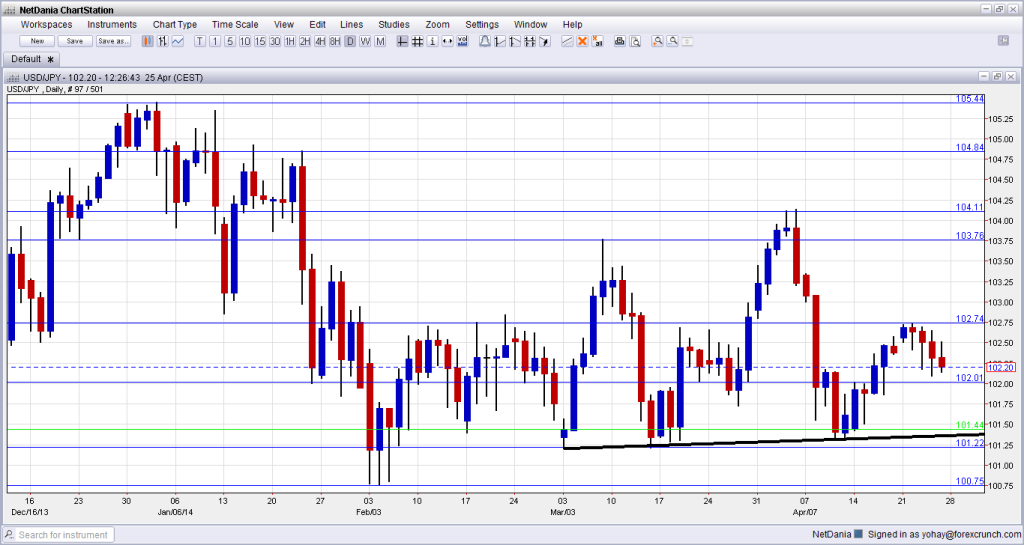The Japanese yen had a relatively relaxed trading week, sticking to the known range. This will probably change now. A busy week awaits traders with the rate decision standing out. Here is an outlook on the major events moving the yen and an updated technical analysis for USD/JPY.
Japan reported the widest trade deficit on record: no less than 1.71 trillion yen. The unimpressive rise in exports despite a weak yen is certainly worrying for policymakers. The battle against inflation is making progress, but the post tax hike inflation numbers came out below expectations. Is this enough to trigger new stimulus from the BOJ?
[do action=”autoupdate” tag=”USDJPYUpdate”/]USD/JPY graph with support and resistance lines on it. Click to enlarge:
- Retail Sales: Sunday, 23:50. Japanese retail sales enjoyed nice year over year gains in recent months, reaching 3.6% in February. The month of March was the last one before the sales tax hike, and a much bigger rise is expected. A weak or similar figure could ring alarm bells.
- Manufacturing PMI: Tuesday, 23:15. Markit’s survey of around 300 managers has shown a drop in expected growth levels: from 55.5 to 53.9 points in March. For April, a bigger drop is feared after the sales tax hike came into effect. If the index remains above the 50 point mark separating growth from contraction, policymakers could make a sigh of relief.
- Industrial Production: Tuesday, 23:50. This is the initial figure for March, and a revision is expected afterwards. February saw a disappointing drop of 2.3% in output after two months of rises. While this indicator is volatile, it still has a significant impact. A rise is expected now.
- Average Cash Earnings: Wednesday, 1:30. This year over year measure of salaries is yet another gauge of inflation. The Japanese government called on corporations to raise wages. After remaining flat in February, a minor rise is expected for March.
- Rate decision: Wednesday morning. In the first rate decision after the sales tax hike came into effect, the BOJ preferred a “wait and see” approach. Also this time, it is likely that not enough evidence is available in order to assess if more stimulus is needed. A pledge to maintain current policy until the 2% inflation goal is reached is a more likely scenario. Any unexpected moves are likely to weaken the yen.
- Housing Starts: Wednesday, 5:00. The strong year over year growth in housing starts almost came to a full stop in February, with a growth rate of only 1% after a few months of double digit leaps. This indicator for the construction sector has is expected to post stronger growth now.
- BOJ Outlook Report: Wednesday, 6:00. The broad report from the central bank is released only twice a year and has a significant impact. We could hear what the Bank thinks about the states of the economy, inflation and also the value of the yen.
- Household Spending: Thursday, 23:30. This is an important measure of both consumer confidence and inflation. The 2.5% plunge recorded in February was certainly worrying and cut a series of nice rises. A bounce back for the month of March is likely, due to the tax hike.
- Unemployment Rate: Thursday, 23:30. Japan saw an even lower unemployment rate in February: only 3.6%, an envy to most countries. The same unemployment rate is likely for March.
- Monetary Base: Thursday, 23:50. The Bank of Japan’s policy is via the monetary base. Huge year over year gains have been seen since Kuroda announced his monetary blitz back in April 2013. And now, it is the first time that we will see the y/y figure for April. Is the BOJ buying bonds at the same fast pace?
* All times are GMT.
USD/JPY Technical Analysis
Dollar/yen began the week with a move upwards, but was capped by the 102.74 line discussed last week. The failure to break higher sent it down, but within the range.
Technical lines from top to bottom
The top line is the peak seen in the turn of the year: 105.44. This was challenged several times. Below, 104.80 capped the pair during January.
104.10, the high of April 2014 is currently a minor line, but should be watched. Below, 103.77 provided support for the pair in January and served as a clear separator of ranges.
102.74 was a stubborn peak during February and is the top line of the current trading range. 102.00 is a round number that supported the pair several times and is the botom of the range.
101.20 provided strong support for the pair during March 2014 and is the low line of support. 100.75 prevented the pair from falling lower during February and is the last backstop before the round number of 100.
100 is not just a round number but also worked as resistance several times in the past.
Moderate uptrend support
We can observe a moderate uptrend support line (thick black line) accompanying the pair since early March.
I remain bullish on USD/JPY
There is still a chance that the BOJ will act following the not-totally-convincing inflation numbers for April. More importantly, as the US is about to receive the critical jobs figures for April, the first full month of good weather, we can certainly expect the dollar to rise. Will the pair break out of range?
More:
- GBP/JPY Waiting for Direction in Long-Term Consolidation Pattern
- USDJPY: Sells Off, Target Additional Weakness
Further reading:
- For a broad view of all the week’s major events worldwide, read the USD outlook.
- For EUR/USD, check out the Euro to Dollar forecast.
- For GBP/USD (cable), look into the British Pound forecast.
- For the Australian dollar (Aussie), check out the AUD to USD forecast.
- For USD/CAD (loonie), check out the Canadian dollar forecast.
- For the kiwi, see the NZDUSD forecast.

